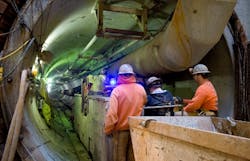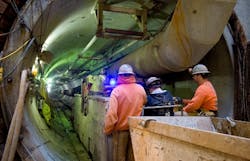SAN FRANCISCO, CA, Oct. 21, 2014 -- On Wednesday, Oct. 15, the San Francisco Public Utilities Commission (SFPUC) joined with Dave Pine, president of the San Mateo County Board of Supervisors, to celebrate the completion of the first tunnel under San Francisco Bay at the location where the first Hetch Hetchy (HH) water enters the Crystal Springs Reservoir.
Eighty years ago this month, a similar celebration occurred in this exact spot when HH water was first delivered to the San Mateo-Peninsula region through Bay Division Pipeline 1. That original lifeline, and the entire HH system, was built in response to the 1906 earthquake and the devastating fires that ensued in its aftermath.
The multi-billion-dollar Water System Improvement Program (WSIP) was a response to the 1989 Loma Prieta Earthquake and the likely seismic event that will occur in the Bay Area in the next 30 years. As one of the last WSIP projects, the Bay Tunnel replaces two aging pipelines (Bay Division 1 & 2) that sit on the Bay floor. The new Bay Tunnel acts as a seismically-reliable lifeline connecting HH and East Bay water supplies with customers on the Peninsula and in San Francisco. Construction on the Bay Tunnel began in April 2010, and it was just put into service after weeks of testing and disinfection. At $288 million, the project was delivered on time and below the original budget estimate of $313 million. "Ratepayers are investing in critical infrastructure upgrades to ensure that precious Hetch Hetchy Water will continue to be delivered after a major seismic event," said Nicole Sandkulla, CEO of the Bay Area Water Supply and Conservation Agency. "The decision to invest 100 percent of ratepayer money now, rather than later, will prepare us for the future major seismic event that we know will occur in our region.""New director hired for SFPUC Water System Improvement Program"
"New pipeline provides backup in earthquake country"
###




